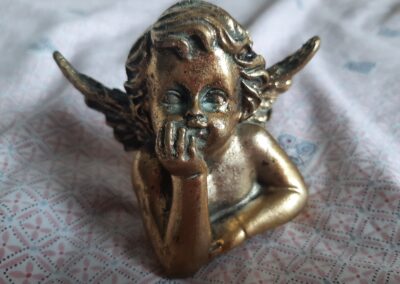The first time we do it, we may not get very far. If we make a habit of doing it slowly, by degrees, then a feel for where we are in life, of what our lives might be about, may swim more clearly into view. As Ludwig Wittgenstein put it:
‘What’s the good of having one philosophical discussion! It’s like having one piano lesson!’
We should take stock of the big questions rather than flip our eyes over them.
Arrival at what seems to be the right decision can be that one’s ‘guts’ are in the right place. Understanding oneself is as much of a challenge as understanding any other issue. Fog can be cast by the tendency of philosophers, politicians, and indeed many people, not to know where to draw the line. There is a tendency to follow things through too far to what seems a logical conclusion. There is a glass ceiling set above what we can hope realistically to attain. Physicists can have a handle on this phenomenon; they realise that at a certain point the law of gravity that holds good on earth is no longer holds true.
A pillar of Meditation – much the same holds true of reflection – is to get into the right frame of mind. That preparation may feed a need simply to ease up on the throttle. A slight shift from the norms of timetabled active life to take time out for Reflection can suffice to get one’s brain and thinking processes in order.
Reflection requires equilibrium, one may have to work at attaining it.
Some ways of Reflection overlap with those of Meditation.
A lit candle, say, or some gentle background music put on – Musak, say, but preferably not singing, which tends to be more intrusive.
Breathing exercises and posture can put one in the mood for reflection. But perhaps gentle music or a joss stick can help acknowledging the start of reflection heightening subliminally its importance? Such a ruse does not have to be of an order that implies an elevation of the soul with a hint of the exotic or the adventurous thrown in but a mere acknowledgement that in a daily timetable time can be legitimately set aside for calm reflection. TV programmes do not morph into one another without some border thrown up, an advertising jingle or other kind of lead-in, the better to prepare our brains for a slightly different form of exercise than that in which they have just been engaged.
Take a step back, mentally, relax, concentrate on your thinking side. It can include your emotional side. Hold up to the light and coddle ideas or feelings swirling around in your thoughts. So much so far for a Socratic method in conversation through which, sometimes via circuitous ways rather than casuistry we can approach the main point perhaps surprising ourselves, and tease out relevant truths en route.
A wholesome perspective is vital, the idea in Frederick Langbridge‘s couplet:
Two men looked out of prison bars
One saw mud, the other stars’.
One may as well use the best tools that are to hand. It can be easier to think your own thoughts and find your best perspective when in a congenial space for a retreat. A Sanctuary is any place that you think is one. It may help you feel comfortable in exploring what is important to you. People who are sensitive to surroundings can choose the backdrop for reflection with care. Its foredrop – to coin a neologism – may work best on the principle that the loftiest thoughts can come to one when in, say, a cathedral
To quote Susie Woodman:
‘Firstly, find a place where you’re comfy. Every morning I sit in my meditation chair in my study. If you try and do it at roughly the same time, in the same place every day, you’ll have a much better chance of building a habit. So gently rest your gaze on a point just in front of you. Notice yourself breathing in and out. If you haven’t done this before, I’d suggest trying it with your eyes open as you’ll stand more chance of staying present. I think if you shut your eyes you’re more likely to nod off or drift off into your thoughts and To Do list. Play around with it and see what works best for you. For me, meditation isn’t about drifting off or falling asleep. You need to be ‘relaxed and comfy, but all your senses need to be activated and you need to be present.’
We look up to early totems. A subconscious voice often is founded on initial impressions in life, then conscious layers later overlay them. We look up to parents and teachers and, as Wordsworth said, ‘the child is father to the man.’ Someone who wishes to attune himself to his inner voice may like to surround himself with scenes or artefacts that call to his mind the early phases of his life, when one was more in touch with one’s original thinking. Marcel Proust1 in ‘In Search of Lost Time’ described how, as a child, his aunt gave him madeleines dipped in tea. To the adult Proust the act of eating a madeleine resurrected the context of his childhood. The memories come to him as a sensual activity without being summoned, not an intellectual one. A conscious act and reminders of congenial former surroundings can help to restore the thread of memory.
Benevolent feelings tend to uplift one to see broader vistas from a higher and more serene vantage point. The Rabbi, Naftali Lowenstein, asked by a tremulous pupil what last minute preparation to make on the day of an exam, advised the examinee to make a donation to charity. She said later that doing so helped put her in the right frame of mind for her task.
Reflecting can be like weeding. Self-destructive feelings or ideas that pursue you should be rooted out. Here is a little trick but anyone can come up with their personalised substitute: try exclaiming ‘WEED!’ whenever ambushed by them. It may be easier for septuagenarians who, as toddlers, saw the TV series: ‘Bill and Ben, the Flower Pot Men’ in which the name of ‘Little Weed’ was spoken in a haunting cadence that tended to stick in the mind, as if to say ‘Better steer clear of this entity!’ This ruse won’t work the first time. Negative thoughts will have already arisen before evasive action can be taken but the self-brainwashing that comes of reiteration of the same thoughts, good or bad, then linking them with a conscious reproof where it is called for can become second nature if the will is there. If all else fails, jab a pin into your flesh by way of aversion therapy! Choose a ruse for use for yourself.
We can dance our days away in a pot purri of often contradictory codes, a combination of unconscious plagiarism and arrogance. We fling ourselves into what we have been flung into, flag-bearers for our totems. This basic truth might just not be visible to the naked eye so why not look into it. We wish to feel that what we think is consistent with our goals and, in doing we may compound illusions by which we live. It is the saddest thing discovering this too late in life.
This whole exercise can help to reset a practical course in life. Self-destructive thought or emotion may arise even after work has been done on alleviating it but can be drained of a capacity to induce fear or anxiety. ‘Bad’ things may happen for inscrutable reason but that is not necessarily a bad thing; some actors deliberately make the most of first night nerves so as to give better performances.
It is preferable not to follow a session of meditation with a busy schedule about which the mind may be turning. In some sects of Zen Buddhism watches are not to be worn. The striking of a gong and/or suitable rubric also helps create a sensation of time out of time.
Insight is more liable to surface when in a calm and rational mood. Emotions and personal demons can be mastered – not necessarily entirely suppressed – so that they can be viewed in a detached way and seen as far as possible for what they are.
If the predominating note in the mind when wanting to reflect is of anger or fear one is liable to be more grounded in the things of this world, more the victim of emotion, less able to reach for the stars – more corralled into one line, one dimension. The last thing needed is to allow the worst thoughts full rein to prey on one’s mind.
Some Meditation sects in the East kick-start sessions with a bout of belly-laughing to ginger up participants into a happy mood and imbue their thinking with a sense of proportion. The same idea can apply with Reflection. How these groups are able to belly-laugh on cue isn’t too clear; perhaps a Swami doubles as a stand-up comic or a Master of Ceremony calls out a number from a shared list of jokes consensually found hysterically funny? Meditators in the West tend not to overdose on slapstick and aim for a calm equilibrium of mind, as do most people who wish to reflect.







